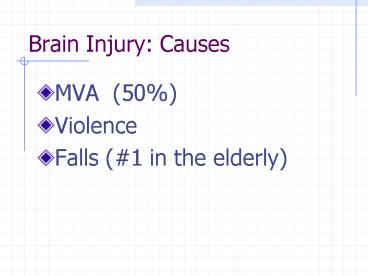Brain Injury: Causes - PowerPoint PPT Presentation
1 / 20
Title:
Brain Injury: Causes
Description:
Visual field cuts. Location of objects. Difficulty recognizing drawn objects. Hallucinations or visual illusions. Difficulty identifying colors. Inability to ... – PowerPoint PPT presentation
Number of Views:55
Avg rating:3.0/5.0
Title: Brain Injury: Causes
1
Brain Injury Causes
- MVA (50)
- Violence
- Falls (1 in the elderly)
2
Facts and Figures
- A little more than 2 of the U.S. population
currently live with disabilities from TBI - 1 million people are treated and released from
ERs each year with TBI - Each year, 80,000 Americans experience the onset
of long term disability with TBI - Each year, 50,000 people die from TBI
3
Risk
- The risk of TBI is highest among adolescents,
young adults, and elders 75 - 2x as many men suffer TBI compared to women
4
Types of injury
- Open
- Closed
- Focal
- Diffuse
- Coup Contrecoup
5
Left Hemisphere Function
- Rational
- Analytical
- Verbal
- Language Systems
6
Left Hemisphere Damage
- Difficulties in speaking, comprehending, reading,
writing, arithmetic calculation, verbal
reasoning, and verbal memory. - May see emotionality, irritability, and an
agitated type of depression.
7
Right Hemisphere Function
- Spatial thinking, integration of parts into
wholes, recognition of faces, musical
appreciation and perception, spatial memory, and
the analysis of the emotional and inflective
aspects of language
8
Right Hemisphere Damage
- Getting lost easily
- Inability to remember peoples faces or other
visually-oriented material - Inability to produce or appreciate drawings or
musical pieces - May see emotional blandness
9
Frontal Lobe Function
- Abstract reasoning, planning, and judgement
- Evaluation of environment and initiation of
response - Controls emotional response and expressive
language - Flexibility in thinking and behavior
- Social appropriateness
10
Frontal Lobe Damage
- Sequencing inability to plan a sequence of
complex movements - Loss of spontaneity
- Perseveration persistence of a single thought
- Mood changes
- Changes in social behavior or personality
- Difficulty with problem solving
- Brocas Aphasia Inability to express language
11
Parietal Lobe Function
- Visual Attention
- Appreciation of bodily sensation
- Sensory-Motor Integration
- Arithmetic
- Manipulation of objects
- Integration and interpretation of input from the
different senses
12
Parietal Lobe Damage
- Inability to attend to more than 1 object
- Anomia inability to name an object
- Alexia problems with reading
- Difficulty drawing objects
- Poor hand-eye coordination
- Difficulty with math
- Difficulty distinguishing left from right
- Lack of awareness of certain body parts and/or
surrounding space
13
Occipital Lobe Function
- Vision and higher-order visual processing
- Reading
- Recognition of faces
14
Occipital Lobe Damage
- Visual field cuts
- Location of objects
- Difficulty recognizing drawn objects
- Hallucinations or visual illusions
- Difficulty identifying colors
- Inability to recognize words
- Difficulties with reading and writing
15
Temporal Lobe Function
- Hearing and higher-order auditory processing
- Oral language comprehension
- Musical appreciation
- Verbal memory and visuospatial memory
- Emotional experience and expression
16
Temporal Lobe Damage
- Wernickes Aphasia Difficulty understanding
spoken words - Short-term memory loss and interference with
long-term memory - Inability to categorize objects
- Difficulty identifying and verbalizing about
objects - Persistent talking
- Increased aggressive behavior
17
Brain Stem Function
- Breathing
- Heart Rate
- Swallowing
- Startle Response
- Alertness and sleep
- ANS (sweating, BP, digestion, temp)
- Sense of balance
18
Brain Stem Damage
- Dysphagia swallowing food and water
- Dizziness and nausea
- Problems with balance and movement
- Sleep problems
- Decreased breathing capacity
19
Cerebellum Function
- Coordination of voluntary movement
- Balance and equilibrium
- Some memory for reflex motor acts
20
Cerebellum Damage
- Loss of ability to coordinate fine movements
- Loss of ability to walk
- Inability to reach out and grab objects
- Tremors
- Dizziness
- Slurred Speech
- Inability to make rapid movements































